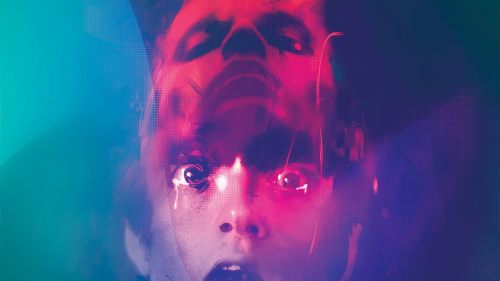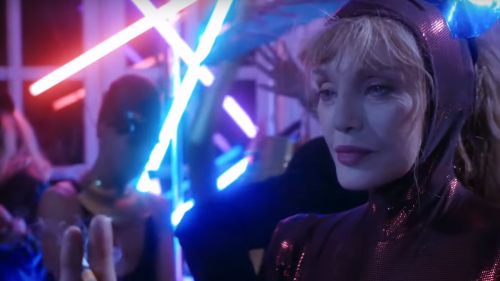Fantasia 2019: DANIEL ISN’T REAL’s Creators On Imaginary Friends And Real Fear
It’s been said that children who have imaginary friends grow up to be more creative adults, so it makes sense to ask the creatives behind Daniel Isn’t Real, a tense supernatural take on the subject, whether they ever had one.
“I have a strong memory from when I was a really little kid of having an egg-shaped imaginary friend named Mr. Nobody,” says co-scripter/director Adam Egypt Mortimer. “I recall introducing my dad to him and eating lunch with him. I was very young at the time, and it was like he was really there with me. Also, my stuffed animals were very much alive back then, so it was important to me to incorporate that into this movie. There’s a cat puppet named Wilbur who’s like a character running through the first part of the film.”
“I did not have a specific one,” says Brian DeLeeuw, who co-wrote the film and authored its source novel In This Way I Was Saved. “I had whole imaginary worlds and things like that, but there was never one consistent character. That was an invention for this story.”
In Daniel Isn’t Real, making its Canadian premiere tonight at the Fantasia International Film Festival and going into general release later this year, the titular companion first appears to protagonist Luke when he’s a little boy. Unfortunately, he proves to be a bad influence, and Luke’s mom forces him to mentally lock Daniel away. Years later, when Luke (Miles Robbins from Halloween) heads off to college, Daniel reappears in his life as a confident, charismatic young man (Patrick Schwarzenegger) who helps Luke get over his social awkwardness. He also gets up to his old, manipulative tricks again, leading Luke down a dark path of bad behavior and mental disintegration.
Mortimer and DeLeeuw first met about eight years ago, before the former had helmed a feature, and when he read In This Way I Was Saved, he suggested they collaborate on a film version. “We wrote the script,” Mortimer says, “and it was a big, epic-scaled story, with lots of special effects and all these locations and crazy fight scenes, so I was like, ‘Brian, I don’t think we can’t actually make this movie right now; let’s do something smaller.’ So that prompted us to write Some Kind of Hate.”
That 2015 film centers on a tormented teen at a desert reform school who inadvertently conjures up the ghost of a girl who was bullied to death, and who begins killing off those who mistreat him. “There are parts of Daniel Isn’t Real that are very similar to Some Kind of Hate thematically,” Mortimer notes, “but this movie is so much bigger, and not in such a specific genre. I don’t know what genre it is; it’s childhood-fantastical, it’s strange body horror, and it’s similar to a Bret Easton Ellis young-people drama.”
“There are psychological thriller elements as well,” DeLeeuw adds, “where Some Kind of Hate had sort of a laser focus; it was a supernatural slasher movie. This is more amorphous when it comes to genre.”
In adapting In This Way I Was Saved, the duo had to make some necessary alterations for dramatic purposes. Among other things, the novel tells the story from Daniel’s point of view, and Mortimer notes, “I don’t remember ever thinking that the movie should be done that way. It always felt like it should be focused on Luke. One thing that happened as a result, and I don’t want to give anything away, but in the first draft of the script there was a major revelation, and by the time we got to the final version, it was the opposite.”
“It’s hard to talk about the specifics of it without spoiling it,” DeLeeuw says. “The book is more ambiguous about what he’s talking about, and we knew that to make a good movie, we had to come down on one side or the other.”
They also had one simple ambition: “Make it more exciting and awesome than Some Kind of Hate,” Mortimer laughs. “Seriously, there were times when we would look at the final version of our first movie and be like, ‘This could be more awesome,’ or, ‘Why are they talking here? There should be something awesome happening.’ I think we put more awesomeness into Daniel Isn’t Real; this movie is densely packed with awesome. It moves really quickly, and there’s always some crazy shit happening.”
“There is no filler,” DeLeeuw says. “I don’t think that derives from [my feelings about] Some Kind of Hate, but from some other scripts I’ve written. It’s like, less of the characters talking about things that happened to them in the past, and more showing things happening to them right now! That was the biggest transition, actually, in shifting from writing books to screenplays: the way you deal with the past and with time and with backstory. That’s an area where I’ve learned a lot, from that first movie to this one.”
The right young leads were also key, of course, and they wound up casting a couple of second-generation actors: Robbins is the son of Tim, and Schwarzenegger…well, you know. “We went all over the place looking for the right people,” Mortimer says. “I met Miles and thought he was such an interesting person, and as soon as he read for Luke, everybody agreed on him. Actually, he tried out for both characters, so I got to see a lot of range from him. The character of Daniel had to be bigger than life, with a striking look and feel, wearing these amazing clothes. And Patrick is an international fashion model on top of everything else, and has sort of an almost post-human quality. He’s definitely a unique character.”
Daniel Isn’t Real is also atypical for a fright film, and Mortimer aimed to follow in the footsteps of classic genre movies that offered a little something more. “Early on when we were writing this,” the director says, “we talked about Guillermo del Toro, especially Pan’s Labyrinth, in the way that film has a fantastical world with all these monsters and it’s super-scary, but it’s also a coming-of-age story and it’s about the war and the environment they’re in. That was an important inspiration for us, and so was The Exorcist, which is unparalleled; it functions as an incredible family drama for 45 minutes, and then becomes a truly visceral horror movie. American Psycho is another film we thought about a lot that’s totally a horror movie, but it’s also something completely different. That’s what we’re shooting for here. I’d say this movie is like if David Cronenberg directed Beetlejuice; that’s the vibe we went for.”


